Last updated on May 7th, 2025 at 10:37 am

Fracture at the lower end of the humerus in the elbow joint, between two condyles is termed an intercondylar fracture. Commonly happens due to falling on the tip of the elbow. Intercondylar fracture of the humerus is found more in adult people and elderly people.
But, in elderly people, it is more of due to osteoporosis. Almost all intercondylar fracture sufferer has a history fall directly on the elbow.
In this article, we will discuss what actually is an intercondylar fracture humerus what are its common causes and most importantly, the post-operative rehabilitation exercises.
Intercondylar fracture humerus
Intercondylar fracture of the humerus is the fracture of the lower part of humerus bone between the medial epicondyle and lateral epicondyle. The fracture involves the joint surface of the lower humerus which takes part in the formation of the elbow joint.
To simplify it, it is the fracture through the trochlea which extends upwards and split it into the fractured part. Intercondylar fracture is sometimes also associated with supracondylar fracture humerus.
The lower part of the humerus bone takes part in the formation of the elbow joint along with the upper part of the ulna and radius bone. In the lower part of the humerus bone, the medial prominence is called the medial epicondyle and lateral prominence is called lateral epicondyles.
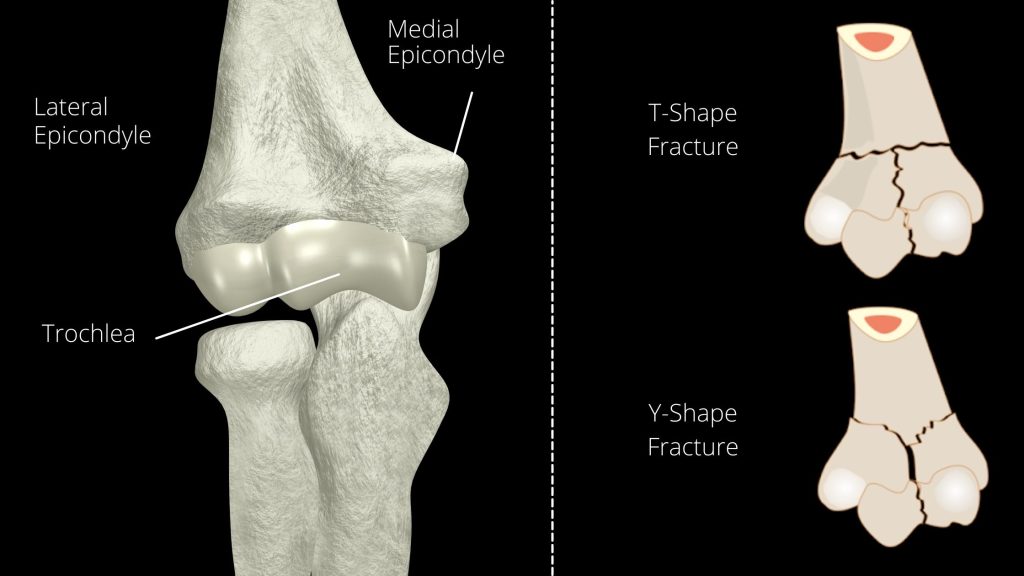
If the fall is of less impact then the fractured condyles will be divided into two half. But, in case of more severe impact, there is a chance of comminuted fracture (fracture into multiple fragments).
Whatever may the type of fracture, due to the involvement of the joint surface of the humerus bone, is going to affect the movement of the elbow joint.
Between the two condyles, there is a grooved surface that we call trochlea. On the trochlea, the upper part of the ulna bone makes the movement. Just palpate over the tip of the elbow. The pointed part of the bone is the olecranon process. It is the upper part of the ulna bone.
Classification of intercondylar fracture
The fracture may divide the
What causes distal humerus fracture
Intercondylar fracture of humerus results because of direct fall on the tip of the elbow. In my 12 years of career, I have seen many intercondylar fractures resulting due to
When one falls on the tip of the elbow, it drives the olecranon process is into the trochlea, resulting in bone fracture into fragments.
Treatment option
Treatment of intercondylar fracture of humerus differs on displaced or undisplaced fracture. In an undisplaced fracture, posterior slab immobilisation is done. Immobilization is done with the elbow in flexion position of 90-degree shoulder sling is given for 2-3 weeks.
In a displaced intercondylar fracture of the humerus, the reduction of the fracture segment is done under general anaesthesia. Following which posterior slab immobilization is given for 2-3 weeks.
Complicated cases are managed differently. Skin traction is applied to the lower end of the humerus. In some cases, internal fixation has to be done using a screw and plate.
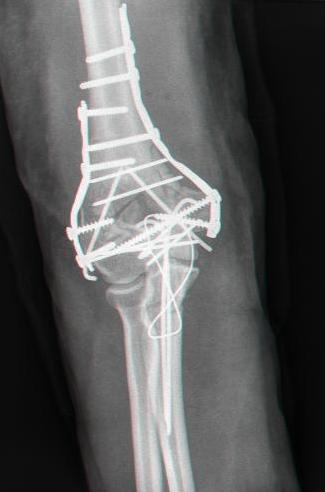
By Mehlauge – Centro Medico La Paz, Bata, Äquatorialguinea, Public Domain, Link
Download: Elbow fracture physiotherapy rehabilitation exercises pdf
In this article, we are going to learn just an overview of the protocol. However, if you need a complete step-by-step guide with clear and colourful illustrations and instructions, I suggest you download the Elbow Fracture Rehabilitation Protocol Simplified by clicking the button below.
Post-op intercondylar fracture physiotherapy management
Post-operatively the elbow joint is immobilised by a posterior mould splint, and the arm & forearm is supported on a sling. This splint immobilisation is kept for 6 weeks. Due to the long term plaster immobilisation there develop elbow joint stiffness.
However, the stiffness is not restricted to the elbow, it also affects the wrist and shoulder joint.
To prevent stiffness, the exercises should begin immediately after surgery when the medical condition becomes stable. We have to start with light exercises and then progress to a more severe one as we progress.
This is why the post-operative period is divided into 4 phases. These are weeks 0 to 3, week 3 to 6, week 6 to 10 and week 10 to 12 onwards.
Note: Perform all these exercises a minimum of twice daily, however, if you do it for 3 to 4 times it’s even better.
Post-operative Week 0 to 3
To reduce the complications, one should start physiotherapy immediately post-operative. With the splint on, we have to start exercises for wrist and shoulder joints.
Remember, we have to avoid active elbow extension 6 weeks post-operative. So, let us start with wrist joint range of motion exercises.
Active wrist flexion-extension
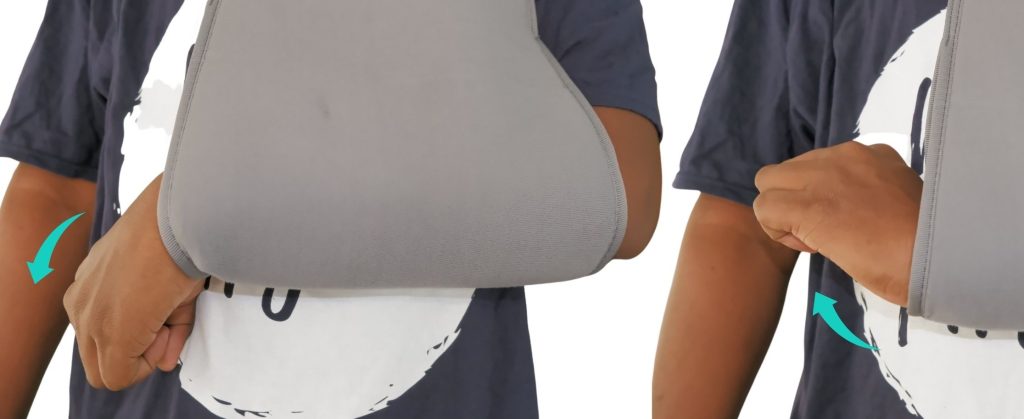
With the forearm supported on the sling, move your wrist joint up and down as shown in the figure. This will not only prevent wrist joint stiffness it will also help in improving the blood circulation around the forearm. This will also maintain forearm muscle tone.
Do for a minimum of 20 repetitions in s session, however, the more you do the better it is. Perform this whenever you find the time when sitting ideal, watching television.
Wrist circumduction
The next wrist exercise is wrist circumduction. This is also a wrist ROM exercise intended to prevent wrist stiffness. For this, you just need to rotate your wrist as shown in the figure. Rotate it in both clockwise and anti-clockwise directions.
Do as many repetitions as possible.
Grip strength exercise
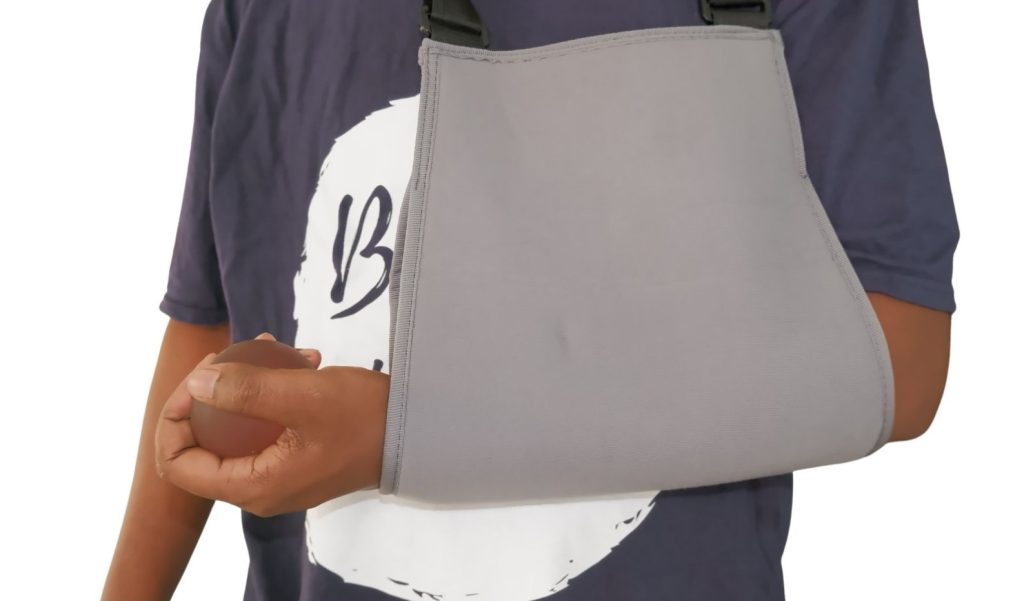
Due to the long-term immobilization, it is natural that the grip strength would be affected and it becomes weak. Grip weakness is clearly visible when we try to hold a glass of water.
So strengthening the grip is also very important and it is also important to carry on with other coming exercises.
For this exercise, take a gel ball or a sponge ball and squeeze it with your affected hand. This will also help in improving blood circulation around and this, in turn, will help in fracture healing. Do it for as many repetitions as possible.
Shoulder adduction abduction
There’s a high chance that the shoulder joint can also get stiff and exercising it should be our priority. This shoulder exercise is done in a standing position. Stand comfortably and support the affected forearm on the opposite hand.
In this position, move shoulder slowly in right and left direction as shown in the figure. Do it 15 to 20 times in a session.
Shoulder flexion exercise

Support your forearm on other hand and move slowly shoulder forward. Flex the shoulder up to the point where you can take it comfortable and then back slowly. Repeat this a minimum of 15 to 20 times in a session.
Week 3 to 6 post-operatively
After the 3rd and between the 6th week, you can remove the splint during exercise. You have to repeat all the exercises we just discussed for the wrist joint and shoulder joint.
You can increase the repetitions of exercises. However, you should still avoid movement at the elbow joint.
Week 6 to 10
By the 6th week, the posterior elbow brace is removed and now we should focus on elbow ROM and strengthening exercises. We have to take care of elbow flexion, extension and forearm pronation, supination.
Active wrist flexion extension
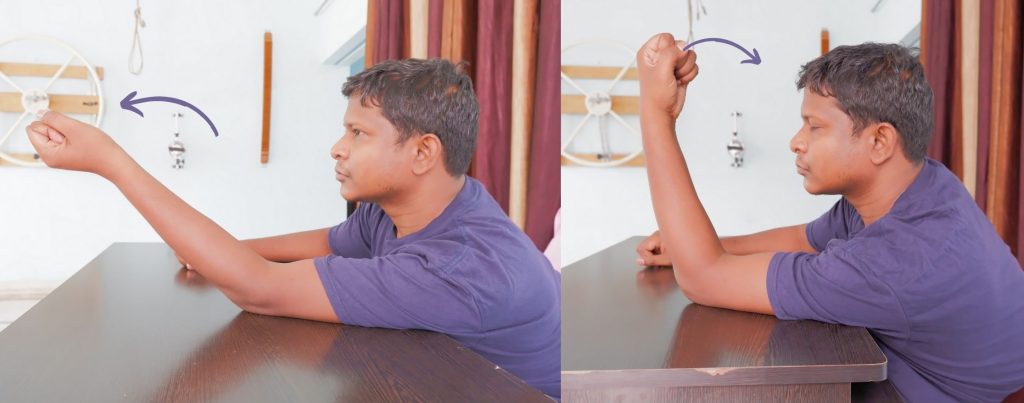
In a normal elbow, joint four movements occur, i.e flexion, extension and pronation, supination. First, we would aim at restoring elbow flexion and extension motion.
For this sit comfortably in front of a table and place your arm of the affected side on the table. Keep the arms flat on the table to make a good base of support to perform elbow exercise. In this starting position straighten the elbow as much as it could, this is termed as an extension of the elbow.
After extending it to maximum slowly bend the elbow, i.e flex it to the maximum point. Repeat this alternate flexion extension a minimum of 15 to 20 times in a session.
Wrist circumduction exercise
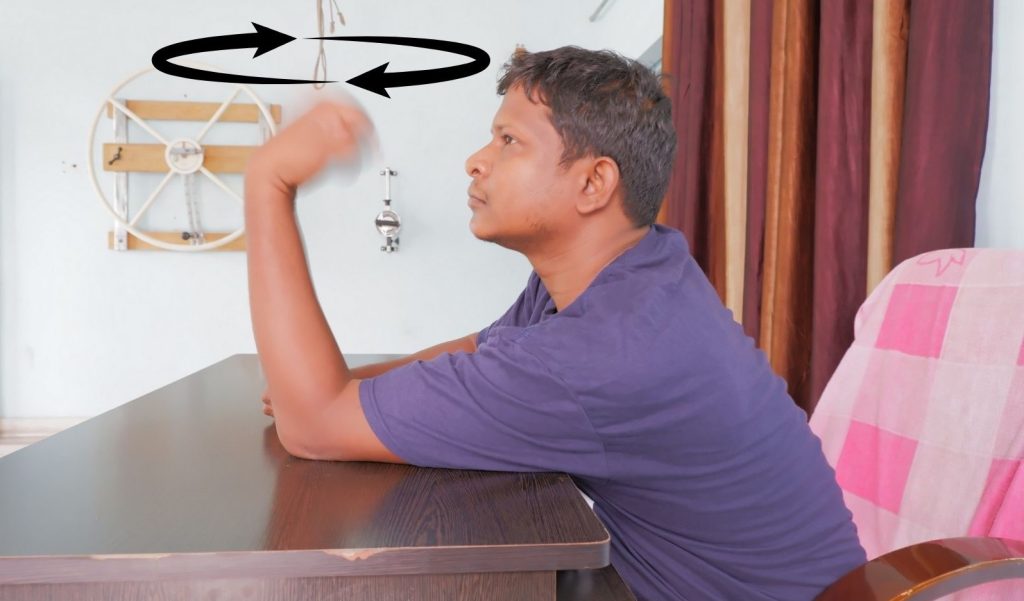
For this exercise, our starting position would be similar to the previous exercise. In this resting position try to rotate your wrist joint. Rotate it in both clockwise and anticlockwise directions.
Rotate it clockwise 15 to 20 times and then anticlockwise 15 to 20 times, however, you can perform this exercise as many times as you could.
Stretching of wrist flexor and extensor
This is a stretching exercise for the wrist and our starting position would remain the same. Here we have to use our opposite hand and slightly put pressure at the end range of wrist flexion and extension.
For example, to stretch the flexors, slightly extend the wrist and use the other hand to give pressure over the palm. Press and hold this position for a minimum of 30 seconds duration.
Now repeat the same process by extending the wrist to stretch the flexor group of muscles.
Forearm supination, pronation exercise for broken arm
In the list of exercises for the shaft of humerus fracture, forearm pronation and supination is another important elbow joint motion to take care of. For this exercise our starting position would be quite different, this time stabilize the forearm by keeping it flat on the table as in the figure.
Now in this position rotate your forearm clockwise and anticlockwise, clockwise rotation is called supination and anticlockwise is termed forearm pronation.
You can do this exercise freely without holding anything, but as you progress with the exercise I recommend you to hold a cane or a lightweight rod and then move the forearm in both directions. The momentum created by the cane will help make exercise more effective.
Shoulder forward elevation
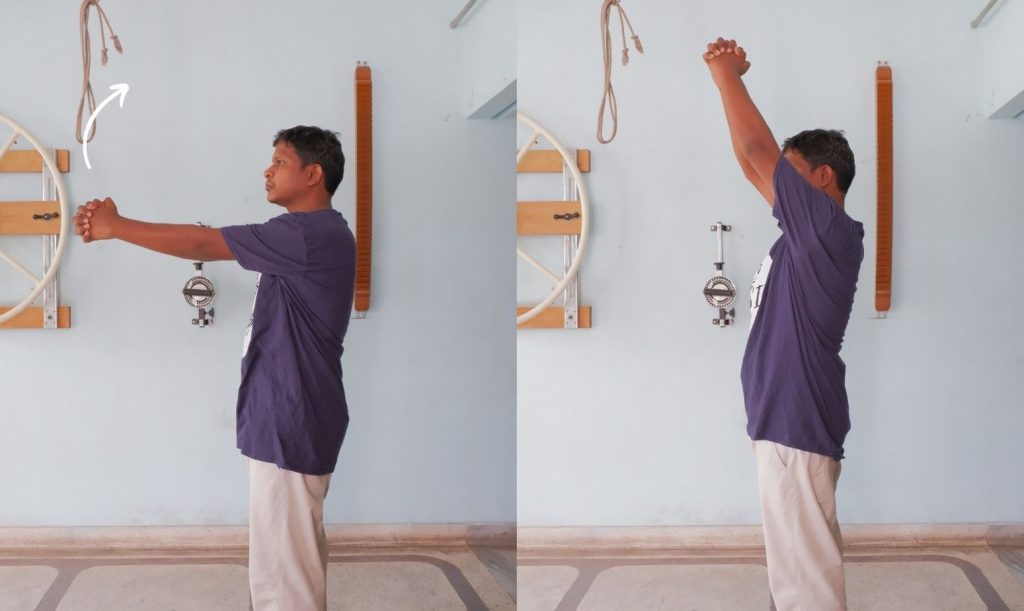
Often shoulder joint stiffness is ignored in such conditions. Shoulder stiffness can become problematic if not taken care of. We have to start shoulder exercises along with other exercises.
I have already covered in detail the various other types of shoulder stiffness exercises which you can read by visiting this link.
So, this shoulder elevation exercise is a very simple, basic exercise. For this, simply grasp your hand and elevate it to the maximum point where you can take it to. Elevate it and then lower it down and then repeat the same process 15 to 20 times in a single session. Twice daily is recommended.
Stretching of elbow flexor muscle

Once again a very important stretching exercise for managing the shaft of humerus fracture. This is a stretching exercise for elbow flexors and extensors groups of muscles.
Flexor muscles are present on the front of the elbow and their action brings flexon movement to the elbow joint. Extensor muscle brings extension/ straightening of the elbow joint and is present on the back of the elbow.
Let us start with stretching of elbow flexors, for this first straighten your elbow to the maximum. In this extended elbow position, put slight overpressure with the opposite hand till you feel a comfortable stretch on the front of the elbow. Hold this stretched position for a minimum of 30 sec.
Repeat the same process to stretch the elbow extensors, but this time by bending the elbow. Do it 3 to 5 times in a single session.
Weeks 10-12+
Gradually return to light activity and exercise. No further activity restrictions after 12 weeks
Progressive strengthening exercises
For this exercise, we need 1.5 to 2 kg of dumbbells. This exercise is recommended only if you have gained sufficient grip strength to hold the dumbbell firmly.
Stand straight and hold the dumbbell with the affected side hand. Hold it and allow the weight of the dumbbell to exert stretching on the elbow joint. Hold it for 1 minute to 5 minutes as per your convenience. As you become comfortable, you can increase the weight of dumbbells up to 5 kg,
The author is a physiotherapist who has been practising for the last 17 years. He holds a Bachelor's in Physiotherapy (BPT) from SVNIRTAR (Swami Vivekananda National Institute of Rehabilitation and Research), one of the prestigious physiotherapy schools in India.
Whatever he learns dealing with his patient, he shares it with the world through blogs and e-books. He also owns a YouTube channel, "Sunit Physiotherapist" with over 8 lakh active subscribers. Here, he shares everything he gets to learn serving the patient.

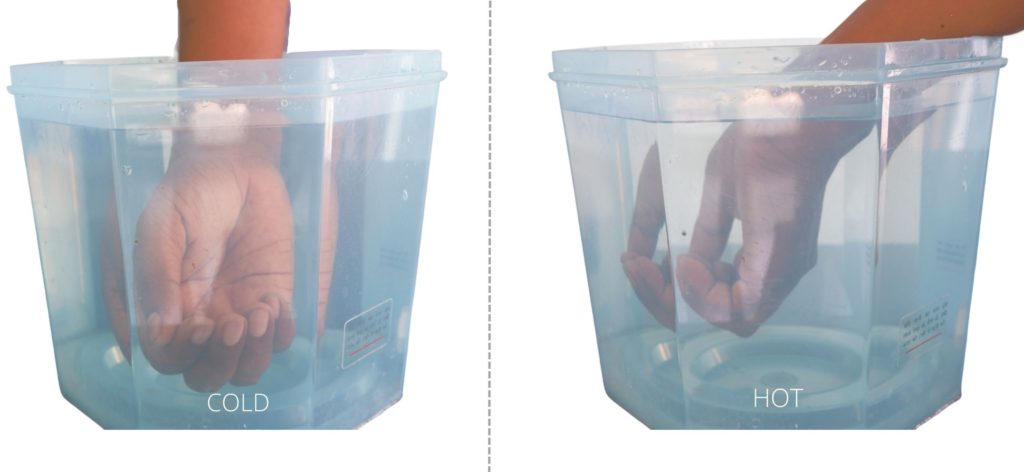


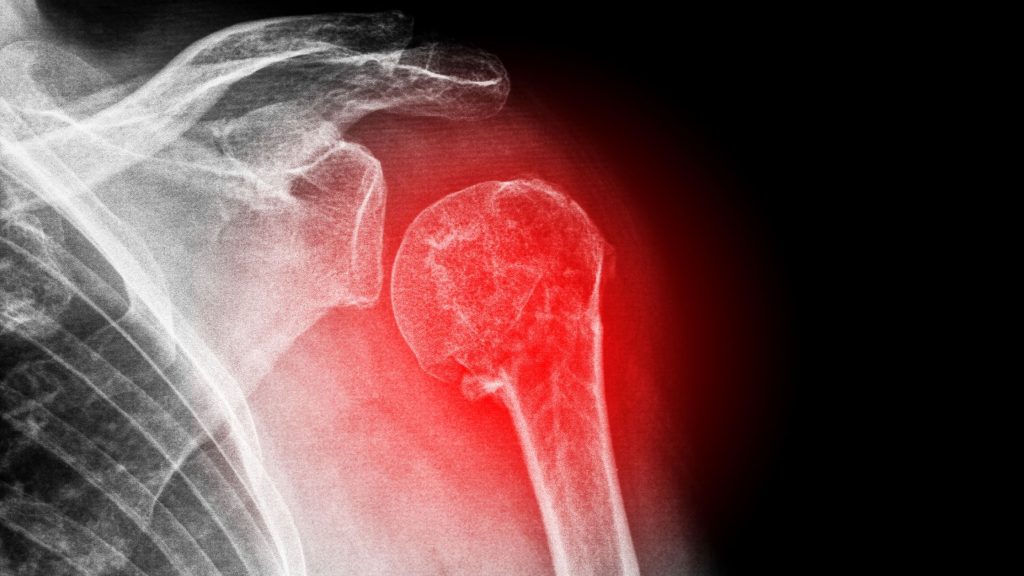
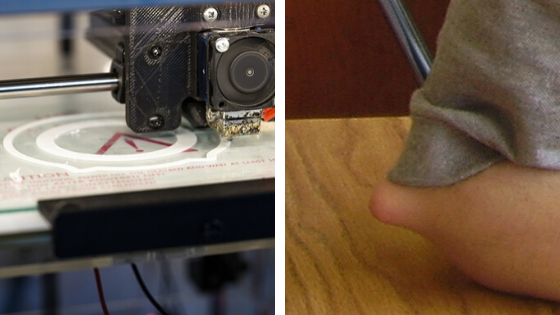
Pingback: 9 Easy Supracondylar Fracture Humerus Physiotherapy Exercises| Elbow Fracture - Physiosunit
Pingback: What's Carrying Angle of Elbow? Its Anatomy - Physiosunit
Nice post, Thank you for sharing valuable information. I enjoyed reading this post. The whole blog is very nice found some good stuff and good information here Thanks for sharing…Also visit my page.
acupressure mat
Keep Posting:)
Nice post, Thank you for sharing valuable information. I enjoyed reading this post. The whole blog is very nice found some good stuff and good information here Thanks for sharing…Also visit my page.
Premium Folding Wheelchair